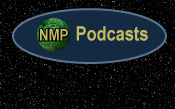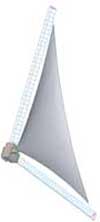Return to Current Site

|
Completed NMP Missions:
Deep Space 1 (DS1) tested 12 advanced technologies, including the xenon ion propulsion engine. DS1 flew an very sucessful extended mission to study Comet Borrelly, returning the best comet5 images and data ever to that date.
Earth Observing 1 (EO1) tested two advanced imaging technologies of unprecedented clarity: Hyperion (the world's only hyperspectral satellite sensor utilizing 220-bands of the spectrum at approximately 30-meter or 98.4 ft. spatial resolution) and the Advanced Land Imager (a lightweight, high performance, multi-spectral sensor). The EO-1 spacecraft was also used as a testbed to validate the NMP Space Technology 6 Autonomous Sciencecraft software. EO1 is now (2006) in an extended mission, expanding public access to its data and transforming the mission into an advanced development sensor web and testbed activity.
Space Technology 5 (ST5) flew three miniaturized satellites, called small-sats or nanosats, in Earth's magnetosphere. The primary mission of ST5 was to validate several technologies in miniatured form, as well as the methods for manufacturing multiple small satellites. As a secondary science data gathering mission, ST5 mapped the intensity and direction of magnetic fields. This data allows scientists to infer the presence of electrical currents carried by energetic charged particles. Studying this region may yield important information about the space weather that disrupts our communication, navigation, and power systems. The mission was completed in June 2006, with successful validation of all tested technologies.
The mission of Space Technology 6 (ST6) is to validate two revolutionary technologies: the Inertial Stellar Compass (Compass) and the Autonomous Sciencecraft Experiment (Sciencecraft). Compass will provide the capability of low-power, low-mass, and high-precision attitude determination for long duration space science missions. This technology will be particularly beneficial for future small-sat missions. Sciencecraft technology (validation completed on the EO1 testbed in 2004) will equip future missions with significant onboard decision-making, allowing them to take advantage of novel science opportunities. For example, Sciencecraft may be used to capture science phenomena and identify regions where change——new flooding, ice melt, or lava flows——have occurred. Sciencecraft software has already been used on ther Mars Exploration Rovers Spirit and Opportunity to detect and image Martian dust devils. In-development NMP Missions
Space Technology 7 (ST7) will test the Disturbance Reduction System (DRS). Working in conjunction with enhanced sensor technology provided by the European Space Agency (ESA), the enhanced micronewton thrusters of ST7 complete a position-measurement technology that can be used to test theories of gravity, map the gravity fields of the Earth or other planets to study properties of planetary crust and ocean currents, and detect cosmic gravitational waves. ST7's DRS technology, along with ESA's LISA Technology Package Intertial Sensor, will be used by the Laser Interferometer Space Antenna (LISA), the first dedicated in-space gravitational-wave observatory. There is also a preliminary plan to use the DRS in the future EX-5 mission, which will map the Earth's variable gravity field.
Space Technology 8 (ST8) will space validate four new subsystem-level technologies never before tried in space. These include (1) a Dependable Multiprocessor—a commercial-off-the-shelf (COTS)-based computing architecture that can automatically adapt in real time to the error-causing radiation environment of space; (2) UltraFlex 175—an ultra-lightweight, deployable solar array system that is a highly efficient power producer for the entire spacecraft; (3) SAILMAST—a technology for strong, ultra-lightweight structures that can be used to support huge, deployable solar sails and other large structures; and (4) the Thermal Loop—a miniature thermal management system for small spacecraft that tightly controls the operating temperatures of the instruments while using little power. Near Future NMP MissionsSpace Technology 9 (ST9) will test system-level technology selected from the concept areas of consideration within solar sail system technology, formation flying system technology, system technology for large space telescopes, descent and terminal guidance for pinpoint landing and hazard avoidance, and aerocapture system technology for planetary missions. |














